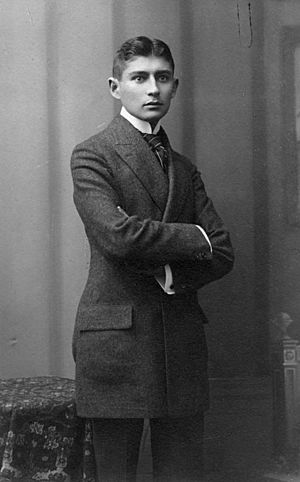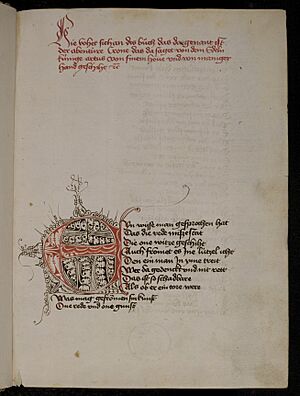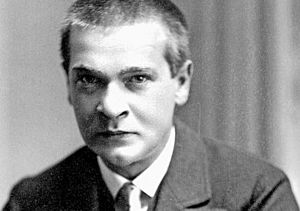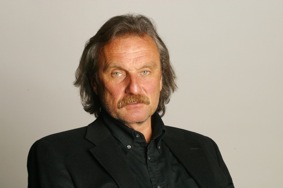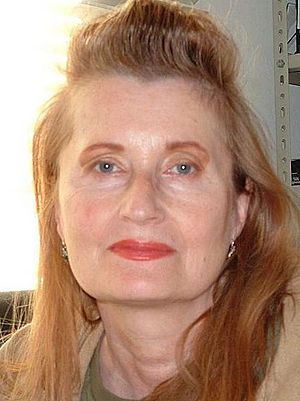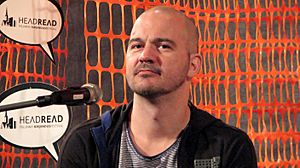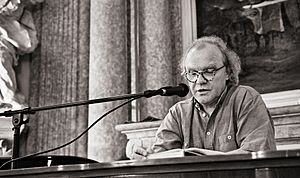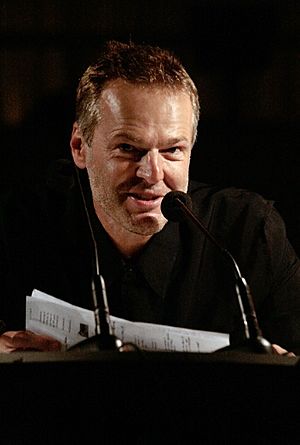Austrian literature facts for kids
Austrian literature (German: Österreichische Literatur) is mostly written in German. It is very closely connected with German literature, but it also has its own unique history and style.
Contents
What is Austrian Literature?
For a long time, Austria was known more for its beautiful buildings and amazing music than for its books. In the 18th century, a visitor even noted that she didn't meet any writers in Vienna!
There were a few reasons for this.
- The royal court saw art as a way to show power, like grand palaces or music. Literature wasn't seen as useful for this.
- German literature itself was still developing.
- There were strict rules about what could be published, which made it hard for new ideas to grow.
- Austrian culture was very focused on beauty and fantasy, which was great for music and art, but not always for new kinds of writing.
However, by the late 1800s, things changed. Austria became more open, and a lot of great writers started to appear.
Famous Austrian Writers
Austria has been home to many famous writers over the years.
- Novelists and short-story writers: Adalbert Stifter, Arthur Schnitzler, Franz Werfel, Stefan Zweig, Franz Kafka, Thomas Bernhard, Joseph Roth, and Robert Musil.
- Poets: Georg Trakl, Rose Ausländer, Franz Grillparzer, Rainer Maria Rilke, and Paul Celan.
- Modern writers: Elfriede Jelinek and Peter Handke are well-known playwrights and novelists. Robert Menasse and Karl-Markus Gauß are famous essayists.
Defining Austrian Literature
It's tricky to say exactly what "Austrian literature" is because it has changed so much over time. It grew from many different regions and languages.
In the Middle Ages, people and storytellers traveled along the Danube River, sharing new ideas. At the same time, isolated valleys in the Alps developed their own unique cultures. This mix of local traditions and shared influences has always been a part of Austrian writing.
The Habsburg monarchy was a huge empire with many different groups of people. Cities like Prague, Budapest, and Vienna had their own traditions. For example, Franz Kafka wrote in German, but he was from Prague and was Jewish. So, he was a "German-speaking, Jewish writer from Prague in the Austro-Hungarian Empire." This shows how diverse Austrian literature can be!
Early Austrian Literature
Middle Ages (750–1500)
The first German texts were written around 750 AD. They were mostly translations of Latin religious books. Monasteries in places like Melk and Salzburg were important centers for writing and religious activities.
Ava (1060–1127) was the first known German female writer. She wrote religious poems and lived in what is now Austria.
Knights and Minnesang (1170–1500)
During the Crusades, knights became very important. A new type of song and poetry called minnesang became popular. These songs were about love, war, and even politics. Traveling poets, called Minnesänger, moved along the Danube River, sharing new songs and stories.
- The first known male writers in German were Der von Kürenberg and Dietmar von Aist (12th century).
- One of the most important works of this time was Nibelungenlied, a famous epic poem. It was likely created in Austria by an unknown poet.
- Walther von der Vogelweide (13th century), one of the most famous German poets, learned his skills in Vienna.
- Other well-known minnesang poets include Neidhart, Jans der Enikel, Ulrich von Liechtenstein, and Oswald von Wolkenstein.
Later, minnesang became a craft practiced by townspeople, called meistersinger. Michael Beheim was a meistersinger connected to the court in Vienna.
Plays also started to develop, especially religious plays about the Passion of Christ. Das Wiener Passionsspiel is a good example.
Heinrich von dem Tuerlîn wrote a long poem called Diu Crône (The Crown), which is about the Holy Grail. It has about 30,000 lines!
Renaissance (around 1600)
The Renaissance was a time when people rediscovered ancient Greek and Roman cultures. This movement spread from Italy across Europe. Emperor Maximilian I strongly supported it. He brought humanists like Conrad Celtes to his court in Vienna.
Eleonore of Austria translated a popular French adventure novel into German. Some important Catholic Church figures, like Nicholas of Cusa, also had connections to the Austrian court and wrote some works in German.
Baroque (17th and 18th centuries)
The Thirty Years War (1618-1648) had a big impact on writers. Some wrote about the suffering, while others wrote religious texts or humorous stories to help people escape reality.
- Abraham a Sancta Clara wrote religious and funny works.
- Catharina Regina von Greiffenberg wrote religious poetry.
To counter the Protestant movement, many Catholic schools were founded in Austria by the Jesuit order. These schools created plays and operas that were very grand and impressive. Sermons were also a very important type of literature during this time.
Another popular form was improvised plays called "Hanswurstspiele," known for their humor.
Enlightenment (around 1720)
The Enlightenment was a time when people focused on reason and learning. Literature started to be used to educate readers. Ideas from ancient Greek and Roman cultures, like harmony and beauty, became very important.
This period was influenced by Freemasonry and often criticized the clergy. So, literature became more educational and satirical.
- The literary magazine Wienerischer Musen-Almanach was a key meeting point for writers.
- Johann Baptist von Alxinger wrote epic poems inspired by Freemasonry and anti-clerical ideas.
- Joseph Schreyvogel greatly improved the quality of Austrian theater.
- Johann Nepomuk von Kalchberg wrote historical dramas.
19th Century Literature
First Half of 19th Century (1790–1848)
The early 19th century saw a mix of ideas. The Napoleonic Wars made many people want literature that offered an escape into fantasy or new hope through religious writing.
- Klemens Maria Hofbauer, Eduard von Bauernfeld, and Franz Grillparzer were influenced by these events.
- The German writer Karl Wilhelm Friedrich von Schlegel also worked in Vienna.
Biedermeier (1815–1848)
The Biedermeier period (1815-1848) was a time of growing cities and industries, which led to a new middle class. Writers from this period were often middle-class, unlike the earlier Romantics who were mostly from the nobility.
After the Napoleonic Wars, there was also more political control and censorship. This meant writers often focused on safe, non-political topics like historical stories or quiet country life. Political discussions happened more privately, among friends. This tension eventually led to the revolutions across Europe.
- Notable poets were Nikolaus Lenau and Franz Grillparzer. Grillparzer is often called a representative of "Austrian Classicism."
- Playwrights included Franz Grillparzer, Friedrich Halm, Johann Nepomuk Nestroy, and Ferdinand Raimund. Nestroy and Raimund were known for their popular Viennese plays.
- Charles Sealsfield (Karl Postl) lived in the US and wrote novels about the Wild West. He also managed to criticize Austrian absolutism without being caught by authorities.
- The end of Biedermeier is marked by the works of Adalbert Stifter (1805–1868). His novel Nachsommer is considered one of the finest Biedermeier works. Stifter influenced many later German writers.
Realism (Late 19th Century)
Austrian Realism focused on showing life as it truly was.
- Ferdinand von Saar wrote short novels.
- Marie von Ebner-Eschenbach was known for her psychological novels and stories, and her focus on social issues.
- Bertha von Suttner wrote social novels. She won the Nobel Peace Prize in 1905 for her novel Die Waffen nieder (Lay Down Your Arms), which was about peace.
Unlike Germany, Austria didn't really develop a Naturalism movement. Instead, it moved towards Jugendstil (Art Nouveau) and Expressionism.
20th Century Literature
First Half of the 20th Century
The Jugendstil movement was mainly about art and architecture, but it also included writers. Viennese writers like Arthur Schnitzler and Stefan Zweig are often linked to this movement. Schnitzler wrote many novels, short stories, and plays between 1890 and the end of World War I.
Prague was a very important center for German-speaking, often Jewish, authors who greatly influenced Austrian and world literature.
- Famous writers from Prague included Oskar Baum, Max Brod, Franz Kafka, Egon Erwin Kisch, Gustav Meyrink, Robert Musil, Rainer Maria Rilke, Franz Werfel, and Oskar Wiener.
Expressionism was a movement that focused on expressing emotions. Key figures were the poet Georg Trakl and the playwright Hugo von Hofmannsthal.
After World War I, Austria became a much smaller country. Some Austrian writers moved to new countries, like Kafka and Werfel to Czechoslovakia. Others, like Robert Musil and Rainer Maria Rilke, moved to Vienna. Many Austrians believed that joining Germany was the only way to save the country, which later led to its annexation by Hitler in 1938. Some writers, like Robert Musil, supported this idea, while others, like Stefan Zweig, strongly defended Austria's independence.
The time between the two world wars was very rich for Austrian literature:
- Robert Musil wrote the famous novel The Man without Qualities.
- Stefan Zweig published many essays, stories, and novels.
- Karl Kraus edited the magazine Die Fackel (The Torch).
- Franz Werfel wrote some of his best novels, like The Forty Days of Musa Dagh.
- After Franz Kafka's death, his friend Max Brod published Kafka's unfinished novels.
- Later Nobel Prize winner Elias Canetti lived in Vienna and wrote his novel Auto-da-Fe before fleeing to England.
Austrofascism and Nazi Dictatorship
In the 1930s, political changes in Austria and Germany greatly affected writers. Censorship increased. When the Nazis came to power in Germany in 1933, they started persecuting writers and burning books. This led to a split among Austrian writers. Some supported the Nazis, while others opposed them.
Nazi Germany boycotted liberal Austrian authors, making it hard for them to publish. After Austria was annexed by Hitler in 1938, many writers, especially Jewish ones, were killed or forced to leave the country.
- Stefan Zweig fled to Brazil.
- Franz Werfel escaped to the US.
- Elias Canetti went to England.
- Others, like Jura Soyfer, were killed.
Many Austrian poets wrote in exile, including Ilse Aichinger, Franz Theodor Csokor, Joseph Roth, and Stefan Zweig.
After World War II: Group of Vienna
After World War II, Austrian literature saw many new directions. Some authors returned from concentration camps or exile, while others, who had supported the Nazis, kept their positions. This led to a conservative group of writers who seemed to control literary awards and funding for a while.
Some Austrian authors, like Ilse Aichinger and Ingeborg Bachmann, were part of the German-based Group 47. Both won awards from this group. Paul Celan and Erich Fried were also members.
In 1954, the Wiener Gruppe (Group of Vienna) was formed by H. C. Artmann and others. This group included Friedrich Achleitner, Konrad Bayer, Gerhard Rühm, Oswald Wiener, Ernst Jandl, and Friederike Mayröcker.
Hans Lebert wrote Wolfshaut (Wolf's Skin), a novel about a fictional village called "Silence," which represented how many Austrians stayed silent about the Nazi past.
Heimito von Doderer was known for his detailed novels like The Strudlhofstiege and The Demons.
1970–2000
In 1973, a new writers' group called Grazer Autorenversammlung (GAV) was founded in Graz. It was a protest against the conservative P.E.N. club and became the largest writers' association in Austria.
The late 1960s and 1970s saw a lot of experimental theater. Peter Handke explored new ways of communicating with plays like Offending the Audience. Ernst Jandl and Friederike Mayröcker wrote "Concrete Poetry," focusing on the sounds of words.
Thomas Bernhard (1931–1989) was one of the most important writers after World War II. He wrote many novels, stories, and plays. His work often caused controversy because he criticized how Austrians ignored their Nazi past. His play Heldenplatz refers to the place in Vienna where Adolf Hitler gave his first speech after Austria's annexation.
Marianne Fritz (1948–2007) was known for her long, complex novels, like Dessen Sprache du nicht verstehst. She used a unique, rhythmic language to describe the decline of the Austrian empire.
In the 1980s, a new and distinct Jewish literature emerged.
- Robert Schindel wrote Gebirtig, about Jewish society in Austria and the difficult memories of the Shoah.
- Robert Menasse is known for his novels and essays about Austria.
- Doron Rabinovici also writes about Jewish topics.
Christoph Ransmayr mixes historical facts with fiction. His novel Morbus Kithara imagines an Austria that didn't get help after World War II. He writes about ex-soldiers, ex-Nazis, and concentration camp survivors, showing the complex reality of post-war Austria.
Josef Haslinger wrote the novel Opernball, about a fictional attack at the Vienna Opera Ball that brings a new fascist party to power. Milo Dor also wrote about the danger of extreme right-wing parties.
Essays have a strong tradition in Austrian literature.
- Jean Améry was an important essayist after World War II.
- Friedrich Heer wrote many essays on history, philosophy, and religion.
- Karl-Markus Gauß is a younger essayist who writes about Central and Eastern European cultures.
Some authors from Carinthia write in the Slovene language, like Florjan Lipuš and Cvetka Lipuš. Peter Handke has translated several works from Slovene to German.
Nobel Prizes for Literature
- In 1981, Elias Canetti (1905–1994) received the Nobel Prize in Literature. He was born in Bulgaria but spent much of his life in Vienna and wrote all his books in German. He later moved to London. His famous works include the novel Auto-da-Fe and his memoirs, which offer a look into Austrian society before World War II.
- In 2004, Elfriede Jelinek (*1946) received the Nobel Prize in Literature. She was recognized for her unique writing style that "reveals the absurdity of society's clichés and their subjugating power." She started writing poetry and stories in the 1960s.
21st Century Literature
Many well-known authors like Franzobel, Peter Handke, Elfriede Jelinek, and Robert Schneider continue to publish. There are also many new and exciting writers from a younger generation.
Literary Magazines and Publishers
Literary magazines are important for new writers. Some traditional and important magazines include:
- Literatur und Kritik and Erostepost (from Salzburg)
- Manuskripte, Sterz, Schreibkraft, and Lichtungen (from Graz)
- Wespennest and Kolik (from Vienna)
- Cognac & Biskotten (from Innsbruck)
- DUM (from Lower Austria)
Many Austrian writers also publish their books with larger publishing houses in Germany.
Literature Awards and Support
Austria has many awards and government support for writers and publishers. This support helps publish unique and challenging literary works that might not otherwise be printed. It also helps writers earn a living.
Some literary prizes include:
- Alfred-Gesswein-Literaturpreis
- Erostepost-Literaturpreis
- Franz-Kafka-Preis
- Feldkircher Lyrikpreis
- Wiener Werkstattpreis
- Anton-Wildgans-Preis
- Manuskripte-Preis
Contemporary Authors
Today, many talented writers are publishing novels, plays, essays, and poetry. Some of them include:
- Thomas Glavinic
- Wolf Haas
- Daniel Kehlmann
- Michael Köhlmeier
- Doron Rabinovici
- Julya Rabinowich
- Kathrin Röggla
These authors often publish their books in Germany and Switzerland as well as Austria.
Cultural Melting Pot
Historically, Austrian literature has been a mix of different cultures and ideas. This is still true today, though on a smaller scale. For example, some novelists like Zdenka Becker (from Slovakia), Dimitré Dinev (from Bulgaria), and Vladimir Vertlib (from Russia) have moved to Austria. Their works often explore themes of immigration and different cultures.
Some authors from Austrian minorities, like Cvetka Lipuš (daughter of Florjan Lipuš), write in Slovene and German.
Many Austrian authors choose to live in other countries, like Marlene Streeruwitz and Ann Cotten in Berlin, or Christoph Ransmayr in Ireland. Their experiences abroad often influence their writing.
See Also
 In Spanish: Literatura de Austria para niños
In Spanish: Literatura de Austria para niños
- List of Austrian writers
- List of Austrian women writers
Sources (books)
- Heer, Friedrich: Der Kampf um die österreichische Identität. Böhlau Verlag, Wien 1981/1996/2001, ISBN: 3-205-99333-0
- Herz-Kestranek, Miguel, Konstantin Kaiser and Daniela Strigl (Ed.): In welcher Sprache träumen Sie? Österreichische Exillyrik. Verlag der Theodor Kramer Gesellschaft, Wien 2007, ISBN: 978-3-901602-25-2
- Zeman, Herbert and Fritz P. Knapp (Ed.): Geschichte der Literatur in Österreich. 7 volumes, Akademische Druck- und Verlagsanstalt, Vienna 1994ff., Vol. 1: ISBN: 978-3-201-01611-7, Vol. 2: ISBN: 978-3-201-01721-3 and ISBN: 978-3-201-01812-8, Vol. 7: ISBN: 978-3-201-01687-2
- Zeyringer, Klaus: Österreichische Literatur seit 1945. Haymon Verlag, Innsbruck 2001, ISBN: 978-3-85218-379-4
- Žmegač, Viktor (Ed.): Kleine Geschichte der deutschen Literatur. Von den Anfängen bis zur Gegenwart. Marix, Wiesbaden 2004. ISBN: 3-937715-24-X


